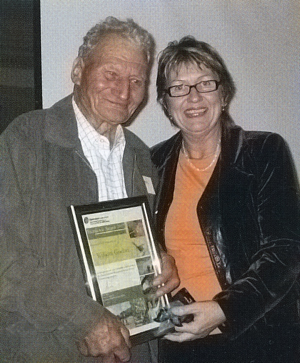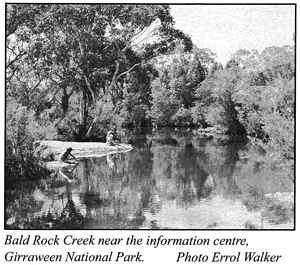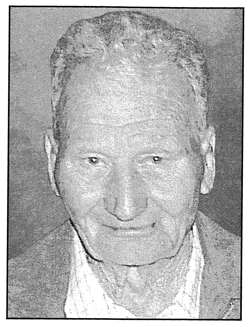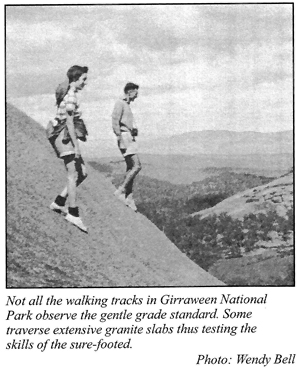|
|
by Bill Goebel, as told to Brian Egan, NPAQ Life Members.
This article was written as a feature in the booklet "National Parks of Queensland - The 100-year Challenge", produced by NPAQ to celebrate the centenary of National Parks in Queensland in 2008. The text and photos from the article have been reproduced here courtesy of the National Parks Association of Queensland.
You can download a copy of the original article here...
|
In June 2007 Bill Goebel received the EPA's Excellence Award for Volunteering - his record at Girraween National Park would be almost impossible to beat anywhere! It's a story of how one dedicated person can accomplish so much for a National Park over the years.
Bill came to Wyberba area in 1931 when his family took up land for farming on Bald Rock Creek, just 2 km east of the present National Park Information Centre. He continues to live at the same site - over 77 years of continuous connection with the farms and grazing areas that have become the present Girraween National park of 11, 800 ha.
He worked as a management ranger in "his" park for 20 years upto 1986, then continued almost full-time as a volunteer for another 21 years. He has a wealth of knowledge of the area and its plants, birds and animals, which he is always happy to share with others.
This is Bill's story but re-told by me in more words than this modest man of few words would use himself.
|
|

Bill Goebel with the former Minister of Environment Lindy Nelson-Carr receiving an award for his voluntary contributions at Girraween National Park.
|
I was nine when we came to the farm on Bald Rock Creek to grow fruit and vegetables. We were too far from the nearest school so we kids were schooled at home - that was after we'd done all our farm jobs each day, of course.
In any slack periods, my 2 brothers and I used to explore the area - the Pyramids were close, Slip Rock was at the back of the farm, up and down the creek led to lots of interesting places, and Castle Rock wasn't far cross-country. Later, when I'd finished schooling early, I had to earn money in non-farm periods at odd jobs or timber cutting. So I learnt a lot more about our area as well as the surrounding districts. This got me a reputation as a feller who knew his way around, and I met some interesting people because of this.
Aboriginal tribes used the area successfully in summer but their place names were lost. There are still rock and tree markings in the park, and there was a main camp at South Bald Rock - I learnt about these while helping some people to locate them.
Explorer Alan Cunningham was the first European in the area, passing through in June 1827 on his return journey south after discovering the Darling Downs. I got interested in this in the 1960s when I was with a historian bloke who wanted to trace his route from his journal. We followed it from near Bald Rock, along Paling Yard Creek and past Billygoat Hill before he turned away to Eukey.
Ballandean was the first station established here in the 1840s, and their shepherds pastured sheep and cattle along Paling Yard Creek, and yarded the sheep at night. They even grew a bit of wheat there and took it to Tenterfield for milling. All the stations were progressively cut up for small selections and miners homesteads after tin was discovered in Stanthorpe in 1872. It wasn't until 1902 that the first blocks in Girraween area were released. Various crops and dairying were tried, most unsuccessfully.
Girraween (place of flowers) has spectacular spring wildflower displays, but it was one man's interest in lyrebirds that produced the first two small National Parks in 1932. Dr Spencer Roberts set up practice in Stanthorpe in 1915, and became very interested in lyrebirds. He got the renowned naturalist Alec Chisholm interested, and in August 1920 they studied lyrebirds and a wombat colony in the Pyramid/Slip Rock area. Chisholm wrote " ... among the great granite boulders, I fraternised with lyrebirds that proved to be a new sub-species ... I named this striking discovery Menura edwardii, Prince Edward's lyrebird."
Dr Roberts campaigned hard to get the government to protect the lyrebirds, and in 1924 two honorary rangers were appointed. In 1932 two small areas totalling 1600 ha were proclaimed as Bald Rock Creek and Castle Rock National Parks, both near us and good lyrebird habitat. It didn't mean anything to me then of course. In 1944 some additional areas were joined to these parks, including the well known Dr Roberts' Waterhole.
Wombats and lyrebirds were the start.
Wombats weren't common but I got more interested in them about 1939 and began looking for them wherever I went. Lyrebirds became an interest a bit later in the 1940s. We'd always known about them since the Pyramids and Slip Rock areas were prime habitat, and that was really just my backyard.
So when Queensland Museum people came up in the 1950s to study lyrebirds, they asked me to help them and I was keen to learn stuff from them. Getting to know lyrebirds better was something I never lost interest in, and over the years I got to know where most of the lyrebirds in the park lived. I wanted to photograph them and tape record their songs, and that meant developing those skills also. They're wonderful birds!
A highlight for me was in early1965 when Sir Henry Abel Smith (Queensland's Governor) came up in his Rolls with Museum staff to see the lyrebirds and listen to their songs. They camped at the back of my house. A bit later he sent up Norm Robinson to record their songs, and we went to Sundown as well to record the different songs there. Sir Henry became a strong advocate for expanding the park, and recommended that our land must become park in due course. Well, the government soon bought up more land, and eventually bought my land in 1976.
|
Bushwalking.
Walking through the area was second nature to me. I'd been doing it for years when the first NPAQ party came up in 1949, to be followed by Brisbane Bushwalkers Club (BBW) in 1950. My truck for carting timber into Wallangarra was pretty useful for carting people and their gear. I also helped them with campsites and took them to interesting places to walk and climb, and to great wildflower areas in spring. I got to love the walking and the friendships, and as they learnt about the country from me, I learnt a lot from them and got more interested in the flowers and plants. I joined both organizations, so I've been an NPAQ member for over 50 years.
This opened up a whole new world for me where people wanted to preserve natural areas, not just for themselves or because it had a particular bird or animal or flowers on it, but because the area was worth protecting for what it was. Knowing Girraween pretty well by now, that sounded like a jolly good idea to me.
|
|

|
|
I also got to visit other great places with them - Carnarvon Gorge in the early 1950s and a bus trip to Alice Springs and Ayers Rock in 1957 stick in my mind.
A lot more people were coming here to walk by the 1960s, but there was no campground, no ranger and no walking tracks. It was hard to get to some spots as trails were indistinct or non-existent. I helped out where I could.
I was out in the bush cutting cordwood for the meat works in 1964 when a lands ranger found me. There was a proposal to establish a shooting lodge on Block 200, he said, but it should be national park. I'll leave it with you, he said. Me! Why me? But I thought about it for a while and told NPAQ.
I didn't hear any more for a month until Herb Hausknecht, head ranger for national parks, turned up and said show me this block. Well, we went out and I walked him over it. OK, it's park, he said, and within a year it was.
From 1965, the government started buying up farms and leases for expanding the park. Herb Hausknecht was back again looking for sites for a campground and information centre. The key site was Gunn's apple orchard which he was willing to sell, and this allowed the two parks to be joined up.
|
In February 1966, the first permanent ranger, Tom Ryan, was appointed. I had casual work with the parks service after that. My tractor and the council grader were used to pull out apple trees and level the picnic area site, then we built the first toilet block and started on a few tracks. More campers came and we built two more sets of toilets in 1969.
In 1970, the Bald Rock Creek camping area was built, separating picnic and camping areas. One Easter 930 campers overflowed into every possible place - it was a mess and so a limit on numbers and a ballot system were introduced. In 1976, the Castle Rock camping area was built to ease the pressure, and an information centre was built in 1977.
Going back again to the 1960s, I was doing voluntary work for the parks by giving slide shows and taking walks. I got to know Herb Hausknecht quite well as he became a regular visitor. In 1969, it was Bill, go out to Carnarvon Gorge to check things out and build a few things. In 1970, it was Bill, go to the Bunyas and help build the first septic toilets at Dandabah. He also got me work at Cunninghams Gap and Queen Mary Falls. And each time I got back home, he'd give me another three months work at Girraween, which was fine by me. But it wasn't until 1975 that I began working full-time for the parks service, when National Parks and Wildlife Service took over from Forestry.
|
|

Bill Goebel
|
In 1976, the decision was made by government to expand the park greatly, upto the NSW border. Syd Curtis came up to look at several blocks including one with South Bald Rock. I showed him the tunnels and other things there, and it was bought. Then John Churchward came up to buy farms in the valley and I helped because I knew all the farms and owners. I helped a bit later with Sundown purchases too.
Well, the first farm to be bought was the Goebel's block. I was happy to see it become part of the park and I continued to live in the house and the small area around it, as long as it was managed according to national park principles. Heck, that was no problem for me!
|
I talked about some of this earlier. The need for decent tracks to replace old trails became more urgent as visitor numbers continued to grow. Track building was a lot of hard work at times, and I was in the thick of it. Bald Rock Creek and The Junction tracks were done in the early 1970s, and then the one to Castle Rock. In 1982 the Dr Roberts Waterhole and Underground R. track was done. We extended Castle Rock in the 1980s to The Sphinx and Turtle Rock, and a bit later to Mt Norman. The track up Mt Norman from the day use area on the back road soon followed. Meanwhile we upgraded the Pyramids track in 1984.
A lot of ranger duties are pretty ho-hum day-to-day stuff but have to be done - maintenance work around the main complex, along the track system and internal management 'roads' and fences. I liked getting out to check these and making sure everything was OK throughout the park. And then there were bushfire times - we sure had a few scary episodes there, and it was sad to see the devastation from the bad wildfires. But I've seen Girraween's ability to recover too.
I enjoyed leading trips for our Park's walks program. I like helping genuinely interested people learn more about our Park's flowers, birds and animals. My colour slide collection was pretty good now and that helped with my talks.
|
|

|
There have been a lot of staff changes in my 40 years, so I've helped them to know the park better also. You get to meet some interesting visitors as well as higher ups in the service and government, and some had to be taken into the back blocks. Weekend camps by NPAQ, BBW and other clubs were always welcome, and I could get permission to take them on trips into otherwise pretty inaccessible areas. That was good for everyone.
So what changed when I retired in 1986 and became a part-time volunteer instead? Nothing much really, except I didn't have the official responsibility any longer. I still turned up for work most days, and helped with whatever I was asked to do. And I'll probably continue as long as I'm able to do it.
I was pretty happy to get EPA's 2007 Excellence Award for Volunteering last year. Working there wasn't just a job, I did it because I love Girraween - the big granite rocks, the lyrebirds and wombats, the flowers and all the other inhabitants of this beaut place.
|
|

